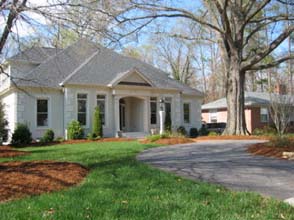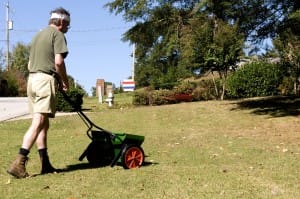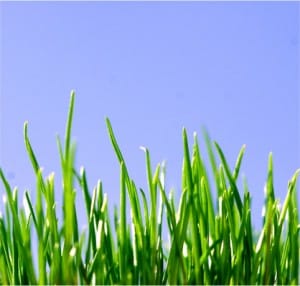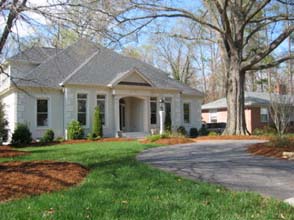Source(s): Clint Waltz, Extension Turfgrass Specialist, The University of Georgia
Tall fescue (Festuca arundinacea) is a popular cool-season grass species that has a bunching to weakly rhizomatous growth habit. Tall fescue is best adapted to Georgia’s piedmont region and is used for home lawns, general areas and for soil stabilization. In general, the southern boundary for tall fescue growth would be Griffin, although, it can be found in shaded or protected microclimates further south.

Because it can be seeded, tall fescue is very popular with do-it-yourself homeowners. Furthermore, its popularity relates to the genetically dark green color during the spring and fall. The use of tall fescue has increased since the introduction of “turf-type” cultivars in the early 1980’s. The turf-type cultivars have darker green color, finer leaf blades, lower growth habit, greater density, and improved shade tolerance compared to the more traditional ‘Kentucky 31’ (K-31) type tall fescues. Additionally, research has shown that some turf-type cultivars have deep extensive root systems and other genetic characteristics for improved drought tolerance.
Establishment
September and October are the ideal months to plant tall fescue. Grass seeded earlier is subject to heat stress and diseases, while planting later leaves the plant vulnerable to cold weather. Seeding in December and early spring is generally not recommended because the plant does not have adequate time to develop a deep root system needed to survive Georgia’s hot summers.
During the summer months, it is common for the canopy of tall fescue to thin and become more open. This is a heat-stress survival mechanism that allows the plant to conserve energy until climatic conditions are favorable for growth. However, a thinned and open canopy makes the tall fescue less competitive and more susceptible to summer annual grassy weeds, like crabgrass. Preemergence herbicides are needed to minimize weed pressure, but research has shown that these herbicides pose the least amount of risk to tall fescue that was seeded the previous September and October. Tall fescue seeded in November and then treated with preemergence herbicides the following February had lower turfgrass quality ratings and reduced stand density compared to tall fescue seeded in October.
Soil Preparation
Proper soil preparation is critical for an effective seed establishment. Ridding the lawn of debris, tilling, incorporating lime and fertilizer, and smoothing the surface are all necessary prior to seeding. Add any amendments such as organic matter or topsoil for soil improvement and till thoroughly into the existing soil. After initial preparation is completed and the area is properly leveled, collect a soil sample to obtain soil fertilizer recommendations. Then incorporate the starter fertilizer and lime 3 to 4 inches into the soil before planting. If equipment permits, tilling deeper is always better.
Seeding
To ensure varietal purity plant seed that is certified and identified by a blue tag. Such seed has been tested and the information on the label is assured by law. In the retail market most tall fescue seed is available as a blend, where several tall fescue cultivars are blended together. Single cultivars are also available but often at a higher price compared to blends. Orchardgrass is a common weed seed contaminate found in tall fescue seed and is easily seen in lawns because of its blue- green color and faster growth rate. Unfortunately, it cannot be selectively controlled with a herbicide.
The ideal seeding rate for tall fescue is 5 pounds per 1,000 square feet. To minimize skips and gaps, it is best to divide the seed into two equal portions and broadcast half in one direction and the remainder at a right angle to the first direction. This procedure is also recommended for fertilizer and granular pesticide applications. The seed can be lightly raked into the upper ¼ inch of soil or pressed into the seedbed with a roller. Applying a straw mulch to retain moisture for improved germination and prevent erosion can be beneficial.
Irrigation
After seeding, keeping the upper 1 to 2 inches of soil moist, not wet, is necessary for uniform germination. This usually means daily watering of about 1/8 to ¼ inch for the first three weeks. As the seedlings develop, irrigate less frequently but wet the soil profile deeper. Under good conditions tall fescue seed will germinate in 5 to 10 days and be ready for its first mowing between 2 and 3 weeks.
Mowing
Begin mowing at a height of 2 inches and as the seedlings mature, raise the cutting height to the 2 ½ to 3 inch range. Once mature, the lawn can be maintained between 2 to 2 ½ inches, but a height of 3 inches is suggested during the summer months. Use a mower with a sharp blade and mow often enough so no more than 1/3 of the leaf height is removed in a single mowing. Do not mow a grass when it is wet, especially young seedlings.
Reseeding
It is common for tall fescue lawns to thin and need periodic reseeding. Turf thinning is usually caused by environmental stresses, improper turf management like insufficient irrigation, too much nitrogen fertilizer, seeding with more than 5 pounds of seed per 1,000 square feet, mowing too low or too high, and seeding in late fall or spring. Additional problems include pests like crabgrass or white grub infestation, or disease problems like brown patch. Soil related problems like a hard compacted rootzone, and environmental conditions where tree shade and root competition compete for water and nutrients also contribute to canopy loss. All of these factors, however, can be mitigated with proper management.
If the lawn needs reseeding, estimate the percentage of tall fescue loss and multiply that number by the establishment seeding rate of 5 pounds per 1,000 square feet. For example, if 50 percent (0.5) of the stand is lost, reseed with 0.5 x 5 = 2.5 pounds per 1,000 square feet. Spring reseeding is less successful because of the shorter establishment time before summer heat and moisture stress.
Getting the seed in contact with the soil is necessary to assure successful reseeding. First, mow the lawn at a height of 1 to 1.5 inches. Disturb the soil preferably by coring or vertical mowing before and/or after seed distribution. This equipment is often available at rental or garden centers. Reseed thin areas at 2 to 5 pounds per 1,000 square feet. Getting the seed below the existing turfgrass canopy and to the soil surface improves germination. Apply a starter fertilizer at 1 pound of nitrogen per 1,000 square feet at this time. Finally, keep the soil moist as discussed for new lawn establishment.
In summary, successful seeding depends on proper soil preparation, good soil-to-seed contact and, proper water management. This and other fact sheets are available at www.gaurbanag.org and www.georgiaturf.com.
Resource(s):
Lawns in Georgia
Center Publication Number: 218



